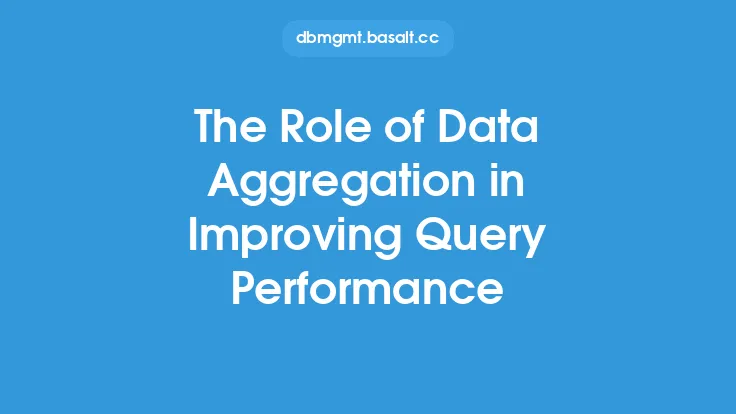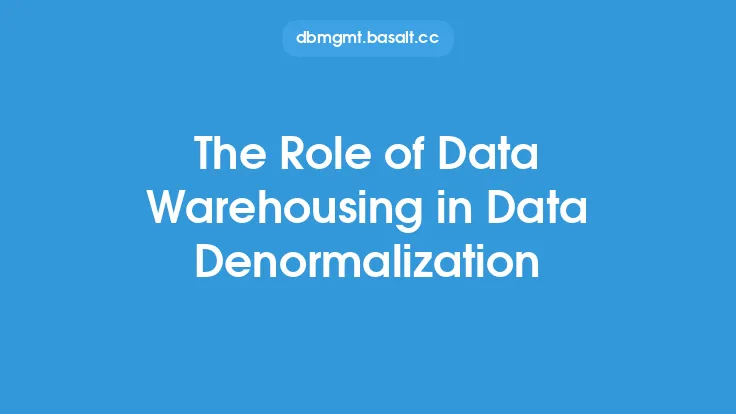Data aggregation is a crucial aspect of data denormalization strategies, playing a vital role in improving the performance and efficiency of databases. By combining data from multiple sources into a single, unified view, data aggregation enables organizations to gain valuable insights, make informed decisions, and drive business growth. In this article, we will delve into the benefits of data aggregation in data denormalization strategies, exploring its advantages, applications, and best practices.
Introduction to Data Aggregation
Data aggregation is the process of gathering and combining data from multiple sources, such as tables, files, or databases, into a single, summarized dataset. This process involves applying aggregate functions, such as sum, average, count, or group by, to the data to extract meaningful patterns, trends, and relationships. Data aggregation is essential in data denormalization strategies, as it helps to reduce data redundancy, improve data integrity, and enhance query performance.
Benefits of Data Aggregation
The benefits of data aggregation in data denormalization strategies are numerous. Some of the most significant advantages include:
- Improved query performance: By aggregating data, organizations can reduce the number of queries required to retrieve data, resulting in faster query execution times and improved system performance.
- Enhanced data analysis: Data aggregation enables organizations to analyze large datasets, identify patterns and trends, and gain valuable insights that inform business decisions.
- Increased data integrity: Data aggregation helps to reduce data redundancy and inconsistencies, ensuring that data is accurate, complete, and up-to-date.
- Better decision-making: By providing a unified view of data, data aggregation enables organizations to make informed decisions, drive business growth, and stay competitive in the market.
Applications of Data Aggregation
Data aggregation has a wide range of applications in various industries, including:
- Business intelligence: Data aggregation is used to analyze customer behavior, sales trends, and market patterns, enabling organizations to make informed decisions and drive business growth.
- Data warehousing: Data aggregation is used to combine data from multiple sources, creating a single, unified view of data that can be used for reporting, analysis, and decision-making.
- Data mining: Data aggregation is used to identify patterns and relationships in large datasets, enabling organizations to gain valuable insights and make informed decisions.
- Real-time analytics: Data aggregation is used to analyze real-time data, enabling organizations to respond quickly to changing market conditions, customer behavior, and other factors.
Best Practices for Data Aggregation
To get the most out of data aggregation, organizations should follow best practices, such as:
- Defining clear goals and objectives: Organizations should clearly define what they want to achieve through data aggregation, ensuring that the process is aligned with business objectives.
- Selecting the right tools and technologies: Organizations should select tools and technologies that are suitable for their data aggregation needs, considering factors such as scalability, performance, and ease of use.
- Ensuring data quality: Organizations should ensure that data is accurate, complete, and up-to-date, using data validation, data cleansing, and data normalization techniques to improve data quality.
- Monitoring and maintaining data aggregation processes: Organizations should regularly monitor and maintain data aggregation processes, ensuring that they are running efficiently and effectively.
Challenges and Limitations of Data Aggregation
While data aggregation offers numerous benefits, it also presents several challenges and limitations, including:
- Data complexity: Data aggregation can be complex, especially when dealing with large, diverse datasets.
- Data quality issues: Poor data quality can affect the accuracy and reliability of aggregated data, leading to incorrect insights and decisions.
- Scalability: Data aggregation can be resource-intensive, requiring significant computational power and storage capacity.
- Security and privacy: Data aggregation can raise security and privacy concerns, especially when dealing with sensitive or personal data.
Future of Data Aggregation
The future of data aggregation is promising, with emerging trends and technologies, such as big data, cloud computing, and artificial intelligence, expected to drive growth and innovation in the field. As data volumes continue to grow, organizations will need to adopt more advanced data aggregation techniques, such as real-time data aggregation, streaming data aggregation, and predictive analytics, to stay competitive and make informed decisions.
Conclusion
In conclusion, data aggregation is a critical component of data denormalization strategies, offering numerous benefits, including improved query performance, enhanced data analysis, and increased data integrity. By following best practices, selecting the right tools and technologies, and addressing challenges and limitations, organizations can unlock the full potential of data aggregation and drive business growth. As the field continues to evolve, it is essential for organizations to stay up-to-date with the latest trends, technologies, and techniques to remain competitive and achieve their goals.





